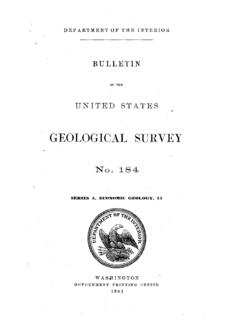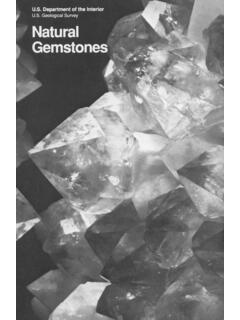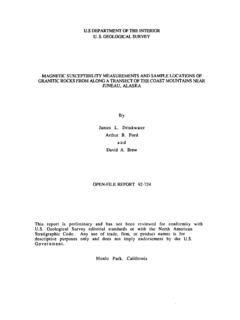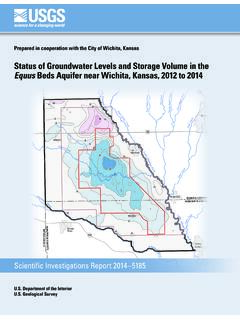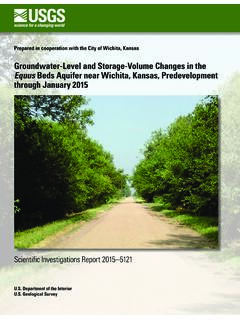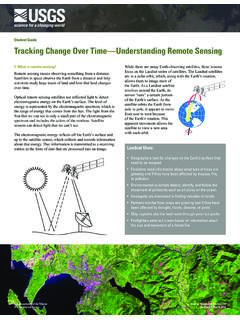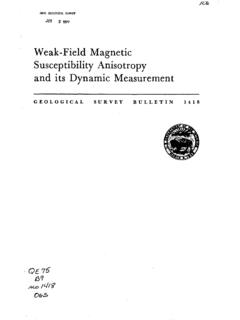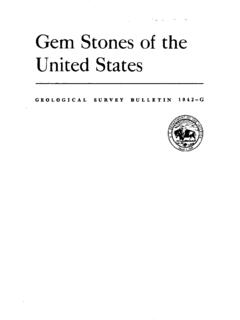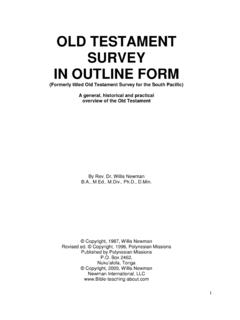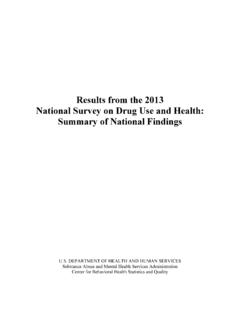Transcription of Gold - USGS
1 Prepared by Kristin N. Sheaffer [(703) 648 4954, gold (Data in metric tons1 of gold content unless otherwise noted) Domestic Production and Use: In 2020, domestic gold mine production was estimated to be about 190 tons, 5% less than that in 2019, and the value was estimated to be about $11 billion. gold was produced in 11 States ( gold mining in Montana ceased in 2019) at more than 40 lode mines, at several large placer mines in Alaska, and numerous smaller placer mines (mostly in Alaska and in the Western States). About 7% of domestic gold was recovered as a byproduct of processing domestic base-metal ores, chiefly copper ores.]
2 The top 26 operations yielded about 99% of the mined gold produced in the United States. Commercial-grade gold was produced at about 15 refineries. A few dozen companies, out of several thousand companies and artisans, dominated the fabrication of gold into commercial products. jewelry manufacturing was heavily concentrated in the New York, NY, and Providence, RI, areas, with lesser concentrations in California, Florida, and Texas. Estimated global consumption was gold -based exchange-traded funds, 34%; jewelry, 30%; physical bar, 12%; official coins and medals and imitation coins, 9%; central banks and other institutions, 7%; electrical and electronics, 6%; and other, 2%.
3 Salient Statistics United States: 2016 2017 2018 2019 2020e Production: Mine 232 237 226 200 190 Refinery: Primary 242 207 205 205 200 Secondary (new and old scrap) 220 119 117 116 120 Imports for consumption2 374 255 213 199 610 Exports2 393 461 474 359 270 Consumption, reported3 210 159 154 151 160 Stocks, Treasury, yearend4 8,140 8,140 8,140 8,140 8,140 Price, dollars per troy ounce5 1,252 1,261 1,272 1,395 1,770 Employment, mine and mill, number6 11,600 11,900 12,200 12,500 12,200 Net import reliance7 as a percentage of apparent consumption E E E E 52 Recycling: In 2020, an estimated 120 tons of new and old scrap was recycled, equivalent to about 75% of reported consumption.
4 The domestic supply of gold from recycling increased slightly compared with that of 2019. Import Sources (2016 19):2 Ores and concentrates: Greece, 44%; Canada, 30%; Ireland, 26%; and other, <1%. Dore: Mexico, 42%; Peru, 16%; Colombia, 12%; Canada, 6%; and other, 24%. Bullion: Canada, 41%; Switzerland, 20%; Peru, 9%; Brazil and Mexico, 7% each; and other, 16%. Combined total: Mexico, 27%; Canada, 21%; Peru, 13%; Colombia, 8%; and other, 31%. Tariff: Item Number Normal Trade Relations 12 31 20 Precious metal ore and concentrates: gold content of silver ores /kg on lead content. gold content of other ores /kg on lead content.
5 gold bullion Free. gold dore Free. gold scrap Free. Depletion Allowance: 15% (domestic), 14% (foreign). Government Stockpile: The Department of the Treasury maintains stocks of gold (see salient statistics above), and the Department of Defense administers a Governmentwide secondary precious-metals recovery program. Events, Trends, and Issues: The United States was not a net exporter of gold in 2020 for the first time since 2010 owing to a significant increase in imports of high-purity gold bullion. The estimated gold price in 2020 was 26% higher than the price in 2019, and 5% higher than the previous record-high annual price in 2012.
6 The Engelhard daily price of gold in 2020 fluctuated through several cycles. Early in the year the gold price was about of $1,580 per troy ounce before decreasing in March and increasing to an alltime high of about $2,060 per troy ounce in August. During this time, several factors were reported to have caused the increase in price: gold demand increased to safe-haven buying as a result of the global COVID-19 pandemic and global investor uncertainty; the Federal Reserve Board cut interest rates; and trade negotiations halted between the United States and China. The price started a downward trend in October and November.
7 Geological survey , Mineral Commodity Summaries, January 2021 gold The 5% decrease in domestic mine production in 2020 was attributed to the COVID-19 pandemic. In 2020, worldwide gold mine production was estimated to be 3% less than that in 2019. Mine production remained unchanged in Argentina, China, Mali, and Sudan, and was slightly less in Australia, Canada, Ghana, and Russia compared with that of 2019. In the first 9 months of 2020, global consumption in physical bars decreased by about 16%, in jewelry by 41%, and in industrial applications by 10%; however, gold consumption in official coins and medals and imitation coins increased by 33% compared with that of the first 9 months of 2019.
8 Global investments in gold -based exchange-traded funds increased by almost 168%, while gold holdings in central banks decreased by about 58% during the same period. World Mine Production and Reserves: Reserves for Canada, Papua New Guinea, Peru, Russia, and South Africa were revised based on Government and (or) industry reports. Mine production Reserves8 2019 2020e United States 200 190 3,000 Argentina 60 60 1,600 Australia 325 320 910,000 Brazil 90 80 2,400 Canada 175 170 2,200 China 380 380 2,000 Ghana 142 140 1,000 Indonesia 139 130 2,600 Kazakhstan 107 100 1,000 Mali 61 61 800 Mexico 111 100 1,400 Papua New Guinea 74 70 1,200 Peru 128 120 2,700 Russia 305 300 7,500 South Africa 105 90 2,700 Sudan 90 90 NA Uzbekistan 93 90 1,800 Other countries 716 750 9,200 World total (rounded) 3,300 3,200 53,000 World Resources.
9 8 An assessment of gold resources indicated 33,000 tons of gold in identified (15,000 tons) and undiscovered (18,000 tons) Nearly one-quarter of the gold in undiscovered resources was estimated to be contained in porphyry copper deposits. The gold resources in the United States, however, are only a small portion of global gold resources. Substitutes: Base metals clad with gold alloys are widely used in electrical and electronic products, and in jewelry to economize on gold ; many of these products are continually redesigned to maintain high-utility standards with lower gold content. Generally, palladium, platinum, and silver may substitute for gold .
10 EEstimated. E Net exporter. NA Not available. 1 One metric ton (1,000 kilograms) = 32, troy ounces. 2 Includes refined bullion, dore, ores, concentrates, and precipitates. Excludes waste and scrap, official monetary gold , gold in fabricated items, gold in coins, and net bullion flow (in tons) to market from foreign stocks at the New York Federal Reserve Bank. 3 Includes gold used in the production of consumer purchased bar, coins, and jewelry. Excludes gold as an investment (except consumer purchased bar and coins). Source: World gold Council. 4 Includes gold in Exchange Stabilization Fund. Stocks were valued at the official price of $ per troy ounce.
